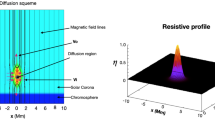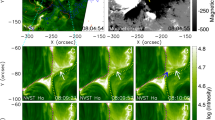Abstract
Solar flare energy release mechanisms often neglect the role played by viscous effects. Here we perform incompressible planar reconnection simulations, driven by the Orszag–Tang vortex, for both classical and Braginskii forms of the viscosity. We show that strongly driven “saturated” flux pile-up current layers, which lead to weak reconnection rates at small resistivities, are accompanied by invariant global viscous losses. These results support the notion that viscous dissipation in flaring plasmas can account for a significant fraction of the flare energy release.




Similar content being viewed by others
References
Armstrong, C.K., Craig, I.J.D.: 2013, Visco-resistive dissipation in transient reconnection driven by the Orszag–Tang vortex. Solar Phys. 282, 441 – 459. doi: 10.1007/s11207-013-0226-7 .
Armstrong, C.K., Craig, I.J.D., Litvinenko, Y.E.: 2011, Viscous effects in time-dependent planar reconnection. Astron. Astrophys. 534, A25. doi: 10.1051/0004-6361/201117657 .
Biskamp, D., Welter, H.: 1980, Coalescence of magnetic islands. Phys. Rev. Lett. 44, 1069 – 1072. doi: 10.1103/PhysRevLett.44.1069 .
Biskamp, D., Schwarz, E., Drake, J.F.: 1995, Ion-controlled collisionless magnetic reconnection. Phys. Rev. Lett. 75, 3850 – 3853. doi: 10.1103/PhysRevLett.75.3850 .
Braginskii, S.I.: 1965, Transport processes in a plasma. Rev. Plasma Phys. 1, 205.
Craig, I.J.D., Litvinenko, Y.E.: 2009, Anisotropic viscous dissipation in three-dimensional magnetic merging solutions. Astron. Astrophys. 501, 755 – 760. doi: 10.1051/0004-6361/200911784 .
Craig, I.J.D., Litvinenko, Y.E., Senanayake, T.: 2005, Viscous effects in planar magnetic X-point reconnection. Astron. Astrophys. 433, 1139 – 1143. doi: 10.1051/0004-6361:20041933 .
Craig, I.J.D., Watson, P.G.: 1999, Dynamic planar magnetic reconnection solutions for incompressible plasmas. Astrophys. J. 516, 924 – 933. doi: 10.1086/307135 .
Heerikhuisen, J., Craig, I.J.D., Watson, P.G.: 2000, Time-dependent magnetic reconnection in two-dimensional periodic geometry. Geophys. Astrophys. Fluid Dyn. 93, 115 – 142. doi: 10.1080/03091920008203724 .
Hollweg, J.V.: 1986, Viscosity and the Chew–Goldberger–Low equations in the solar corona. Astrophys. J. 306, 730 – 739. doi: 10.1086/164382 .
Hosking, R.J., Marinoff, G.M.: 1973, Magneto-viscous effects on the ideal and resistive gravitational instabilities in Cartesian geometry. J. Plasma Phys. 15, 327 – 341. doi: 10.1088/0032-1028/15/5/001 .
Kowal, G., Lazarian, A., Vishniac, E.T., Otmianowska-Mazur, K.: 2009, Numerical tests of fast reconnection in weakly stochastic magnetic fields. Astrophys. J. 700, 63 – 85. doi: 10.1088/0004-637X/700/1/63 .
Lifshitz, E.M., Pitaevskii, L.P.: 1981, Physical Kinetics, Course of Theoretical Physics, Pergamon Press, Oxford.
Litvinenko, Y.E.: 2005, Viscous energy dissipation by flux pile-up merging in the solar corona. Solar Phys. 229, 203 – 212. doi: 10.1007/s11207-005-6882-5 .
Litvinenko, Y.E., Craig, I.J.D.: 1999, Magnetic energy release in flux pile-up merging. Solar Phys. 189, 315 – 329. doi: 10.1023/A:1005258504535 .
Montgomery, D.: 1992, Modifications of magnetohydrodynamics as applied to the solar wind. J. Geophys. Res. 97, 4309. doi: 10.1029/92JA00144 .
Rudiger, G., Kitchatinov, L.L.: 1997, The slender solar tachocline: a magnetic model. Astron. Nachr. 318, 273.
Spitzer, L.: 1962, Physics of Fully Ionized Gases, Interscience Monograph Series, Wiley, New York.
Author information
Authors and Affiliations
Corresponding author
Rights and permissions
About this article
Cite this article
Armstrong, C.K., Craig, I.J.D. Visco-Resistive Dissipation in Strongly Driven Transient Reconnection. Sol Phys 289, 869–877 (2014). https://doi.org/10.1007/s11207-013-0363-z
Received:
Accepted:
Published:
Issue Date:
DOI: https://doi.org/10.1007/s11207-013-0363-z




